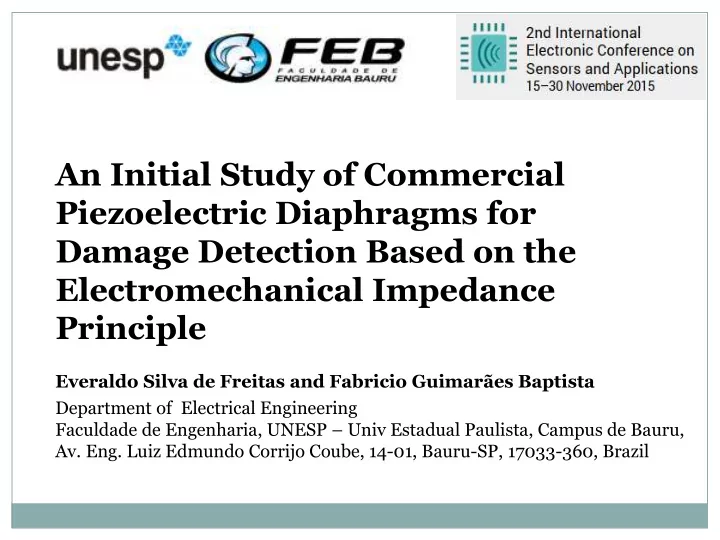

An Initial Study of Commercial Piezoelectric Diaphragms for Damage Detection Based on the Electromechanical Impedance Principle Everaldo Silva de Freitas and Fabricio Guimarães Baptista Department of Electrical Engineering Faculdade de Engenharia, UNESP – Univ Estadual Paulista, Campus de Bauru, Av. Eng. Luiz Edmundo Corrijo Coube, 14-01, Bauru-SP, 17033-360, Brazil
Outline • Structural Health Monitoring (SHM) • Electromechanical Impedance (EMI) Method • Damage Detection • Piezoelectric transducers • Experimental Setup • Results and Discussion • Conclusions
Structural Health Monitoring (SHM) SHM systems monitor the integrity of critical structures such as bridges, dams, aircraft fuselages, pipelines, wind turbines, ships, oilrigs, large machines, among others.
Structural Health Monitoring (SHM) The main objective is to detect damage, such as cracks, corrosion, fatigue, and wears, preferably during the normal operation of the structure, thereby preventing the interruption during the testing process.
Benefits
Electromechanical Impedance (EMI) Method Acoustic Emission Electr omechanical impedance Methods Comparative vacuum Eddy current Lamb waves
Electromechanical Impedance (EMI) Method The EMI method is known for its simplicity and its use of low-cost and lightweight piezoelectric transducers, allowing for multiple transducers to be installed in the structure, enabling a vast area to be monitored without significantly changing the characteristics of the host structure
Electromechanical Impedance (EMI) Method According to equation, any variation in the mechanical impedance “ Z S ( ω ) ” of the structure caused by damage involves a corresponding variation in the electrical impedance “ Z E ( ω ) ” of the transducer
Damage Detection • The detection and quantification of structural damage can be directly performed through damage indices using the real the part of the electrical impedance signatures obtained from a piezoelectric transducer installed in the host structure. In this study we used the CCDM – Correlation coefficient deviation metric.
Conventional PZT Ceramic Piezoelectric Diaphragm (Buzzer) Piezoelectric Transducers Type: 5A Type: 7BB-20-6 Dimensions: Dimensions: Active element 12.7 x 0.191 mm Active element: 14.0 x 0.22 mm Brass plate: 20.0 x 0.20 mm
Experimental Setup - Structures Aluminum beams: 500 x 38 x 3mm Damage was simulated by adding a metal mass (nut) onto the beams at a distance ranging from 40 mm to 360 mm in steps of 80 mm from each transducer Transducers placed using cyanoacrylate glue
Experimental Setup – Measurement System Data acquisition device (DAQ NI-USB-6361) LabVIEW software Excitation signal – a chirp signal with amplitude of 1 V Frequency range of 0-500 kHz Frequency steps of 2 Hz. Sampling rate of 2 MS/s
Results and Discussion Frequency Range Identification e selection of the appropriate frequency range for damage detection is a critical process In this study, the proper frequency range was chosen experimentally by trial and error Thus, the frequency range of 45-55 kHz was determined as the most sensitive to damage, providing high CCDM indices
Results and Discussion Impedance Signatures Comparison between the real part of the impedance signatures obtained from the conventional ceramic and the piezoelectric diaphragm
Results and Discussion Impedance Signatures The impedance signatures obtained from the two transducers show similar trends and resonance peaks, indicating the similarity of the characteristics and behavior of the two transducers In general, the conventional ceramic provides more prominent resonance peaks with high amplitude. In addition, there are small differences in the shape of the signatures, probably due to the effect of the brass plate
Results and Discussion Damage Indices A more effective way to compare the two transducers for sensitivity to detect damage is the use of damage indices In this study, we used the CCDM index , which is based on the correlation coefficient
Results and Discussion CCDM Indices
Results and Discussion CCDM Indices The two transducers provide indices with similar trends for different distances of damage, except for distances of 200 mm and 360 mm, where the diaphragm had provided significant higher indices The experimental results indicate that the piezoelectric diaphragms are feasible for use in damage detection based on the EMI method, providing similar results to those of a conventional PZT ceramic with similar dimensions
Conclusions This study analyzed the applicability of the piezoelectric diaphragms for damage detection based on the principle of electromechanical impedance The results indicate that the diaphragm presents impedance signatures and damage indices similar to those of a conventional ceramic with similar dimensions This work is an initial study. Other important characteristics, such as temperature effects, frequency range and reproducibility of the results, require further research
Acknowledgments The authors would like to thank FAPESP–Sao Paulo Research Foundation (grant 2015/02500-6) for the financial support
Thank You!! Fabricio Guimarães Baptista Everaldo Silva de Freitas fabriciogb@feb.unesp.br everaldo.freitas@feb.unesp.br Department of Electrical Engineering Faculdade de Engenharia UNESP – Universidade Estadual Paulista 17033-360 – Bauru – SP – Brazil
Recommend
More recommend